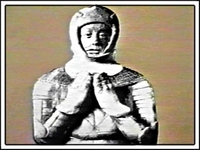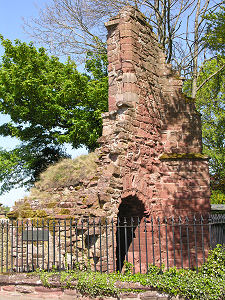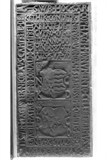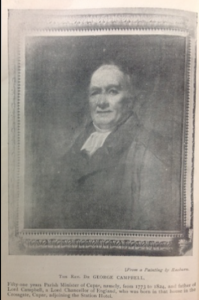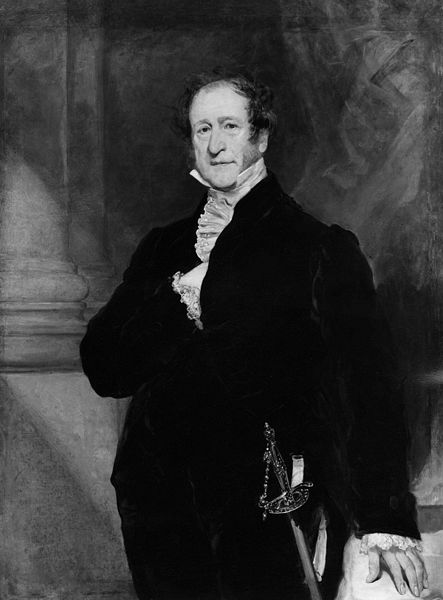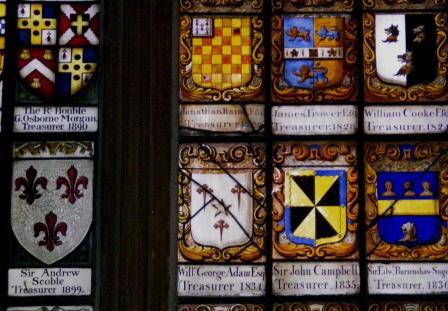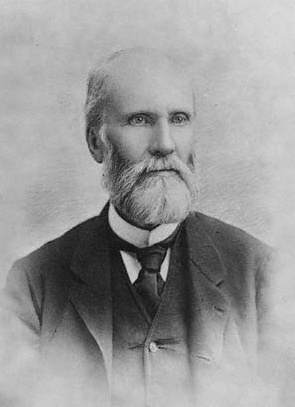My father is descended from a long line of aristocratic Scots of the Campbell clan. The following are my direct ancestors.
Malcolm Campbell (900s or 1000s)
Twenty-fourth great grandfather
Malcolm or Gillocallum. Resident of Normandy and Flanders.
Marriage and issue
First marriage to Dirvaill, daughter of laird of Carrick. Children Gilmmmam of Corearica, partner unknown; sons were the ancestor of MacNaughtys, MacNivens and Mackenzies; Corcarwa ancestor of MacAillins in Ireland and Duncan Drumnanich ancestor of Drummonds in Perthshire.
Second marriage to heiress of Beauchamp ‘Campus bellus’ (niece of William the Conqueror). Children Dionysius / Duncan ancestor of Counts of Tollarn and Gillocallum / Gillespic / Archibald Campbell (d 1091).
Archibald (Gillocallum Gillespic) Campbell (d. 1091)
Twenty-third great grandfather
His father was Malcolm Campbell.
Marriage and issue
He married Eva MacDuibn, daughter of and heiress of Paul O’Dwin (‘Paul the sporran’), the native lord of Lochow.
Their son was Duncan Campbell.
Duncan Campbell (d1097)
Twenty-second great grandfather
Son of Archibald (Gillocallum Gillespic) Campbell and Eva MacDuibn.
Marriage and issue
Married Diorbahil/Dorvail (Dorothy) MacFiachir (daugther of Dugald Cruachan, Thane of Over Lochow). Son Cailen “Maol Math” Campbell.
Cailen “Maol Math” Campbell (d 1100?)
Twenty-first great grandfather.
Son of Duncan Campbell. Born at Lochow; Argyllshire; Scotland
Colin MacDuine of Lochow, (Colin Maol Maith-Good bald Colin) the head of the Clan MacDuine, (through a marriage connection the family became known as the Argyll Campbells and land owners in Argyllshire) enabled King Alexander the First, when disguised as a peasant, to escape from Dunstaffnage Fort during its siege in 1110 AD. Apparently killed during the siege of Dunstaffnage Fort. Dunstaffnage Castle was subsequently built on the site of the fort around 1220.
Marriage and issue
Married Eaill (niece of Alexander I, King of Scots). Sons Gillespic (Archibald) Campbell, Faus Coir Campbell and Iver Croumb Campbell.
Sir Gillespic (Archibald) Campbell (1090-1163)
Twentieth great grandfather.
Gillespic (Archibald) Campbell, of Lochow
Marriage and issue
Son Dubhghall (Dugald) Campbell.
Dubhghall (Dugald) Campbell (d 1222)
Nineteenth great grandfather.
Son of Dubhghall (Dugald) Campbell.
Marriage and issue
Married Finvol Fraser, daughter of John Fraser.
- Sir Gille Escoib or Gilleasbaig (Gillespic/Archibald Campbell) of Menstrie
- Sir Duncan Campbell
- Sir Gillespic /Archibald Campbell (d c 1280)
- Donald Campbell
- Dugald Campbell of Craignish partner(s) unknown
- Faus Coir ancestor of Clan Tavish
- Ivor Croumb ancestor of MacIver Campbells
Sir Gillespic Campbell (d 1280)
Eighteenth great grandfather
Gille Escoib or Gilleasbaig of Menstrie is the earliest member of the Campbell family to be attested in contemporary sources, appearing in royal charters dating to the 1260s. His existence is confirmed by later Campbell pedigrees. According to these genealogies, he was the son of a man named Dubhghall (“Dugald”). However, nothing is known of this man, nor of the 4 or 5 generations of his ancestors who constitute the probable historical section these genealogies preceding Dubhghall. The name Gilleasbaig is a modernization of “Gilla Escoib” (with a variety of related spellings, such as Gille Escoib), and is often rendered as “Archibald” in English or occasionally “Gillespie” or Giilespic.
Gilleasbaig’s first historical appearance dates to 1263, when he appeared in a charter of King Alexander III of Scotland, being named as “Gilascoppe Cambell”. He was granted the estates of Menstrie and Sauchie in Clackmannanshire (but then under the supervision of the sheriff of Stirling). In 1266 he witnessed another royal charter at Stirling granting favours to Lindores Abbey.
Marriage and issue
Married to Afraig, a daughter of Cailean mac Donnchaidh, the brother of Niall, Earl of Carrick. Son Cailean Mór.
Sir Colin Campbell of Lochow (b 1254 – d 1296)
Seventeeth-great-grandfather
Sir Colin Campbell (Colin Mor) of Lochow was son of Gille Escoib, a knight and lord of the estates of Menstrie and Sauchie in Clackmannanshire. Cailean’s mother was Afraig, a daughter of Cailean mac Donnchaidh, the brother of Niall, Earl of Carrick. This means that Cailean himself was the cousin of the future king, Robert I of Scotland, which explains why the Campbells were so attached to the Bruce cause during the Wars of Scottish Independence. Cailean himself took part in the Great Cause, and was one of the Bruce representative advocates to King Edward I of England in 1291.
The Duke of Argyll is also the chief of the Scottish clan of Campbell and in this capacity is known as “MacCailean Mor”, which is Gaelic, for “Son of Colin the Great” referring to Cailean Mór of Lochawe (Colin of Lochow) who was killed in fighting with the Lord of Lorne in 1296. He was knighted in 1280. Cailean Mór (fully, Cailean Mór Caimbeul) or Sir Colin Campbell is one of the earliest attested members of Clan Campbell and an important ancestor figure of the later medieval Earls of Argyll.
He appears as a witness in various documents dating to the 1290s and relating to lordships in south-western Scotland. He appears (c. 1293) in the Newbattle Registrum, after obtaining from Sir Robert Lindsay the estate of Symington is called the son of “Gylascop Kambel” Newbattle Abbey; the document, which has James Stewart, 5th High Steward of Scotland, Lord of Kyle, as one of Cailean’s pledgers, guarantees continued payment of rent to Newbattle Abbey. In 1295, Cailean appears as a witness in a charter of James Stewart granted to Paisley Abbey, and in 1296 appears again in the Paisley Registrum attesting the marriage of James to the sister of Richard de Burgh, Earl of Ulster. Cailean also witnessed a charter of Maol Chaluim, the contemporary Mormaer or Earl of Lennox, and in another Lennox charter in which he is granted lands in Cowal by John Lamont, one of Maol Chaluim’s vassals.
By 1296, and perhaps by 1293, Cailean held the position of “Ballie” of Loch Awe and Ardscotnish, a position he was granted either by King John Balliol or Edward I of England. It was this position that made him the enemy for Iain of Lorn, the MacDougall Lord of Lorne. Sometime after September 1296, Cailean was killed by the MacDougalls at the “Red Ford” on the borders of Loch Awe and Lorne.
Cailean’s great fame lies in the fact that the later Earls and Dukes of Argyll claimed descent from him, and styled themselves “Mac Cailein Mór”, son or descendant of “Colin the Great”. Sir Colin Campbell of Lochow, sixth in descent from the first Gillespie, distinguished himself by his warlike actions, and was knighted by King Alexander the Third in 1280. He added largely to his estates, and on account of his great prowess he obtained the surname of Mohr or More (“great”); from him the chief of the Argyll family is in Gaelic styled Mac Chaillan More.
Sir Colin Campbell had a quarrel with a powerful neighbour of his, the Lord of Lorn, and after he had defeated him, pursuing the victory too eagerly, was slain (in 1294) at a place called the string of Cowal, where a great obelisk was erected over his grave. This is said to have occasioned bitter feuds betwixt the houses of Lochow and Lorn for a long period of years, which were put to an end to by the marriage of the daughter of the Celtic proprietor of Lorn, with John Stewart of Innermeath about 1386.
Marriage and issue
Son Neil Campbell, or Niall mac Cailein (Niall, Colin’s son)
Duncan (Campbells of Loudon)
Dugald?.
Sir Neil Campbell, of Lochow (b before 1270 – d 1316)
Sixteeth-great-grandfather
Niall mac Cailein, also known as Sir Neil Campbell, was a nobleman and warrior who spent his life in the service of King Robert I of Scotland, His Gaelic name means “Niall, Colin’s son” since he was the son of Cailean Mór. His services to the King elevated the Campbells into the higher ranks of the Scottish nobility. He was invested as a Knight circa 1289. In 1296 he joined Robert the Bruce in the struggle against the English. Robert the Bruce granted him, his wife Lady Mary Bruce and their son John, all of the lands of David de Strathbogie, 11th Earl of Atholl. He lived in Lochow, Argyllshire, Scotland. On 26 April 1315 he was one of the great Barons of Parliament which met to fix the succession to the Crown.
Marriage and issue
First marriage unknown daughter Crawford, daughter of Andrew Crawford
child Sir Colin Campbell of Lochow (1316 – 1323).
Second marriage Lady Mary Bruce on 1312, daughter of Robert l (d 1329) , circa 1312.
- Children with Mary Bruce
- Sir John Campbell, 1st and last Earl of Atholl b. c 1313, d. 19 Jul 13331
- Duncan Campbell Macdonnachie of Inverawe+ b. b 1316
Sir Colin Campbell, of Lochow (1280 -1340)
Fifteeth-great-grandfather
Son of Sir Neil Campbell, of Lochow and unknown daughter Crawford. Born and died in Lochow, Argyll, Scotland.
Received a charter from Robert the Bruce, his uncle dated Arbroath, 1316, He obtained a charter from his uncle, King Robert Bruce, of the lands of Lochow and Artornish, dated at Arbroath, 10th February 1316, in which he is designated Colinus filius Cambel, militis. He accompanied the expedition of King Robert I to Ireland in 1316 to win its throne for the King’s brother, Edward Bruce, and in 1334 assisted Robert, 7th High Steward of Scotland, to recover the Castle of Dunoon from the English, following which he was appointed its heritable Keeper in 1334. Had the grant of certain lands for the support of his dignity.
Marriage and issue
Married Helena, daughter of Sir John Mor, son of the Earl of Lennox in 1303. They had three sons (Archibald, his heir; Dugal Campbell of Glassary, married Margaret, sister and heiress of John Glasreth of Glassary and John) and a daughter.
Reported to have had also a natural son, Niall Campbell, ancestor of the Campbells of Melfort.
Sir Archibald Campbell, of Lochow (1310 – 1392)
Fourteeth-great-grandfather
Son of Sir Colin Campbell, of Lochow. Born in Lochow, Argyll, Scotland
1343-1372 son of Colin Oig, was given more lands due to his loyalty to David II. Archibald (or Gillespic) Campbell, Lord of Lochow, was granted several forfeited estates 2 May 1343, and received also from Mary, Countess of Menteith, a grant of Kilmun, confirmed by charter of King David II 11 October 1363.
Marriage and issue
Married Mary (or Isabella) daughter of Sir John Lamont
Had three sons, Duncan, Colin and David, and a daughter, who was married to Duncan Macfarlane of Arrochar. It was probably him who entertained Malcolm MacLeod when the latter saved a Campbell clansman who had been sentenced to be crushed to death by a great bull. Gillespie had promised him the man’s life if he could save it from the bull and so MacLeod took the bull by it’s horns and to cries of “Hold Fast” defeated it.
Colin, the second son, was his heir. He was designed of Ardkinglass and of his family, the Campbells of Ardentinny, Dunoon, Carrick, Skipnish, Blythswood, Shawfield, Rachan, Auchwillan and Dergachie are branches.
Duncan is reported to be the ancestor of the Campbells of Glenfeochan
Sir Colin Campbell, of Lochow (1366 – 1414)
Thirteeth-great-grandfather
He was the son of Sir Archibald Campbell of Lochow and Mary Lamont.
Sir Colin Campbell of Lochow gained the title of Lord of Lochow (feudal barony). He held the office of Lieutenant and Commissary of Argyll in 1382. He lived in Lochow, Argyllshire, Scotland.
Marriage and issue
First marriage Margaret, second daughter of Sir John Drummond 11th of Lennox of Stobhall, and Mary Montifex and sister of Annabella, Queen of Robert III, by whom he had no issue.
Second marriage ante 1 April 1387 his 2nd cousin Mariota (or Margaret) daughter of John Campbell, son of Dugald Campbell, son of Sir Neil Campbell.
Children:
- Duncan, his heir
- John Campbell of Barbreck, ancestor of the Campbells of Inverliver (The Campbells of Succoth claim descent from cadet of the Campbells of Barbreck.)
- Colin Campbell of Ardkinglass m 1396 Christina daughter of Robert MacLayman (alias Lamont) of Inveryne and was the ancestor of the Campbells of Ardentinny, of Auchnawillan, of Carrick, of Dergachy, and of Clachan.
- Dugall Mor Campbell of Dunstaffnage married a daughter of Macdonald of the Isles and was ancestor of the Campbells of Glenamackrie, of Scammadale, of Torry, and of Crackaig.
- Donald Campbell
- Patrick Campbell
- Celestin Campbell
Sir Duncan Campbell, 1st Lord Campbell of Lochhaw (1390 – 1453)
Twelfth-great-grandfather
Son of Sir Colin Campbell, of Lochow and Mariot Campbell. Sir Duncan was created a peer by James II of Scotland in 1445 becoming Duncan Campbell of Lochow, Lord of Argyll, Knight, 1st Lord Campbell.
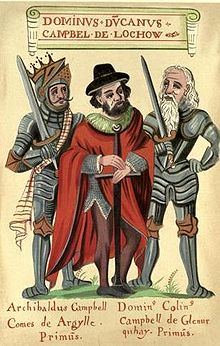
A 16th or 17th century illustration from The Black Book of Taymouth shows Duncan flanked by two of his descendants
A 16th or 17th century illustration from The Black Book of Taymouth shows Duncan flanked by two of his descendants. On Duncan’s right stands his grandson Colin Campbell, 1st Earl of Argyll, here wrongly called Archibald, and on his left is his son Colin of Glenorchy. (Description after Boardman, The Campbells.)
Marriage and issue
First marriage Lady Marjorie Stewart (b. before 1380, d. before Aug 1432), daughter of Regent Robert Stewart, 1st Duke of Albany and Margaret Graham, Countess of Menteith. Had three sons – Celestine, who died before him; Archibald, who also predeceased him, but left a son; and Colin, who was the first of Glenorchy, and ancestor of the Breadalbane family.
Second marriage Margaret Stewart, daughter of Sir John Stewart
Gillespic (Archibald) Campbell, Master of Campbell (b. before 1406 – d. before Mar 1440)
Eleventh-great-grandfather
Second son Sir Duncan Campbell and Lady Marjorie Stewart. Also known as Gillespic. He was styled as Master of Campbell. He lived in Lochow, Argyllshire, Scotland.
Marriage and issue
First marriage Elizabeth Somerville, daughter of John Somerville, 2nd Lord Somerville and Helen Hepburn. Child Colin Campbell, 1st Earl of Argyll
Second marriage unknown Stewart, daughter of Murdoch Stewart, 2nd Duke of Albany
Colin Campbell, 1st Earl of Argyll (c. 1433 – 10 May 1493)
Tenth-great-grandfather
Colin Campbell, 1st Earl of Argyll was the son of Gillespic (Archibald) Campbell, Master of Campbell and and Elizabeth Somerville. Colin Campbell succeeded his grandfather Duncan Campbell, 1st Lord Campbell in 1453, and was created Earl of Argyll in 1457 and Lord Lorne in 1470, after the resignation of his wife’s uncle Walter Stewart, 3rd Lord Lorne, who became Lord Innermeath.
Campbell had supported King James II against the “Black Douglases”, led by the 8th Earl of Douglas, and was given the earldom by King James III. James also gave him the position of Lord Chancellor of Scotland, but he eventually collaborated in the slaying of James III in 1484. In 1488 he became Lord Chancellor again, this time given by James IV of Scotland.

Castle Campbell, lowland seat of the Duke of Argyll, is a medieval castle situated above the town of Dollar, Clackmannanshire, in central Scotland.
The tower house was built in the early 15th century and was known as Castle Glume. The castle was originally a property of the Clan Stuart but passed by marriage to Colin Campbell, 1st Earl of Argyll and Lord Chancellor of Scotland. He had the name of the castle changed to Castle Campbell by an Act of Parliament in 1489.
Marriage and Issue
He married Isabelle Stewart, daughter of John Stewart, 2nd Lord Lorne in 1465. Children:
- Archibald Campbell, 2nd Earl of Argyll
- Thomas Campbell
- Margaret Campbell, married George Seton, 4th Lord Seton
- Isabel Campbell, married William Drummond, Master of Drummond, son to John Drummond, 1st Lord Drummond
- Mary Campbell married Aonghas Óg Lord of the isles.Helen Campbell, married to Hugh Montgomerie, 1st Earl of Eglinton
- Elizabeth Campbell, married John Oliphant, 2nd Lord Oliphant
- Catherine Campbell, married Lachlan Og Maclean
Gillespie Archibald Campbell, 2nd Earl of Argyll (1466 – 9 Sep 1513)
Ninth-great-grandfather
Archibald was the eldest son of Colin Campbell, 1st Earl of Argyll and Isabel Stewart, daughter of John Stewart, 2nd Lord Lorn.
24 Mar 1495: He was made Master of the Royal Household of James IV of Scotland. After a crisis of law and order in the west of Scotland, Archibald was made governor of Tarbert Castle and Baillie of Knapdale, and this was followed by an appointment as Royal Lieutenant in the former Lordship of the Isles on 22 April 1500. Archibald eventually rose to the position of Lord High Chancellor of Scotland. His “clan” was rivalled only by Clan Gordon.
The Earls of Argyll were hereditary Sheriffs of Lorne and Argyll. However, a draft record of the 1504 Parliament of Scotland records a move to request Archibald to hold his Sherriff Court at Perth, where the King and his council could more easily oversee proceedings, if the Earl was found at fault. The historian Norman Macdougall suggests this clause may have been provoked by Archibald’s kinship with 4. These western chiefs supported the suppressed Lordship of the Isles.
Archibald was killed at the Battle of Flodden on 9 September 1513, with the king and many others.
Marriage and issue
Married to Elizabeth Stewart, daughter of John Stewart, 1st Earl of Lennox. Sons include Donald Campbell.
Donald Campbell (d 1562)
Eighth-great-grandfather
16th-century Scottish noble and churchman. He was the 4th son of Archibald Campbell, 2nd Earl of Argyll. From 1522, he was a student of St Salvator’s College, at the University of St Andrews. After graduation, he became a cleric in his home diocese, the diocese of Argyll.
Abbot of Coupar Angus
In May 1525, King James V of Scotland recommended Campbell’s appointment as Abbot of Coupar Angus, a recommendation confirmed by parliament in the following year – despite the fact that the monks of Coupar Angus Abbey had already elected one of their brothers, Alexander Spens, to the position in early 1524. In September 1529, the papacy agreed that Campbell could hold the abbey for eight months in commendam, providing that if he did not become a monk in this period the abbey would thereafter be regarded as vacant; the following February, 1530, he received an eight-month extension to this. Campbell seems to have complied, and was in France in the following months.
Donald was back in Scotland in 1532, attending parliament that year. In May 1533, he was given a five-year appointment as commissioner of the Chapter-General of the Scottish Cistercian Order. While delegating the ordinary business of the abbey to monks, kinsmen and friends, and in Scotland held a variety of high-profile political offices in this period, including Senator of the College of Justice (July 1541), Lord of the Articles for the parliaments of March and December of 1543 and was a member of the Privy Council (June 1545); he had visited France again in 1536.
Bishopric of Dunkeld
In 1549 he secured crown nomination to the bishopric of Dunkeld from the Governor of Scotland, James Hamilton, Duke of Châtellerault. The vacancy was caused by the translation of the previous bishop, John Hamilton, to the archbishopric of St Andrews in 1547.
His appointment was opposed by one Robert Crichton. Crichton was the nephew of George Crichton, Bishop of Dunkeld, and had been appointed coadjutor and successor to his uncle the year before the latter’s death – without the consent of the Scottish government. The government thus ignored the appointment, placing Hamilton in charge. Robert litigated – unsuccessfully – against Hamilton in the Papal see. When Hamilton was translated, Crichton was still litigating. The dispute continued into 1553. When Mary of Guise took over the government from Châtellerault in 1554, she acknowledged Crichton’s position and Campbell appears to have given up the bishopric. In this year, perhaps in compensation, he was made Keeper of the Privy Seal, a position he held until his death in 1562.
Brechin and the Reformation
By 1558, and perhaps as early as 1557, Campbell pursued another bishopric, the bishopric of Brechin, possibly receiving a nomination from Mary of Guise. The vacancy had been caused by the death of Bishop John Hepburn in the early summer of 1557. Campbell’s proctor in Rome, John Row, attempted to gain permission for his master to abandon the dress Cistercian monk and to hold the bishopric of Brechin with the abbacy of Coupar Angus. Campbell never seems to have been awarded the see.
Campbell’s ambition for Brechin was overtaken by the events of the Scottish Reformation. Although he was present at the burning of the Protestant Walter Milne in April 1558, in the following year Abbot Campbell himself became a Protestant and, at the urging of the Lords of the Congregation, abandoned monastic habit, banned mass from his monastery and destroyed its icons and altars. In the following year he attended the Reformation Parliament which severed Scotland’s ties with Rome.
He died sometime between 16 December 1562 and 20 January 1563.
Marriage and issue
Not married but said to have left five illegitimate sons, who were later declared legitimate in order that they might inherit estates of property given to them from the tracts of land formerly belonging to the Catholic Church and redistributed by the state post-Reformation. Two of the sons were David Campbell and Nicholas Campbell of Kethik. It is also possible that Nicholas was born before his father Donald became an abbot.
Nicholas Campbell (1510 – 1587)
Seventh-great-grandfather
Nicholas Campbell of Delvany acquired the lands of Kethick (Keithock) from his brother David circa 1576. Nicholas (Nicol) of Kethick was the natural son of Donald Campbell, Abbot of Coupar.
Gravestone at Bendochy Parish Church
Marriage and issue
Sons include George Campbell.
George Campbell (late 1500 – 1600s)
Sixth-great-grandfather
George Campbell was ruined in his circumstances by joining in a bond of surety for his chief, the 1st Marquis of Argyll, beheaded at the Market Cross of Edinburgh in 1661 on a false charge of having been implicated in the death of King Charles 1. Lord John Campbell writes
My ancestor`s land were judicially sold, and, with the wreck of his fortune, he retired into the county of Fife, where he became owner of the small estate of Baltullo in the parish of Ceres, and of a house in the ancient city of St Andrews, in which he resided till his death. After settling in Fife he was called Chamberlain Campbell, but how he came by his designation I know not.
Marriage and issue
Eldest son John Campbell.
John Campbell (1600s)
Fifth-great-grandfather
The Chamberlain`s eldest son took the degree of M.A. at St Andrews in the year 1677, and gained the highest honours of that University, which then continued to enjoy a considerable portion of the literary splendour it had acquired under the illustrious Buchanan. But he was of an indolent disposition, and, without engaging in any profession, he married a lady of good family but with no fortune, and contrived to live on the scanty means left him by his father. These, such as they were, he transmitted to his son, George.
George Campbell (b late 1600s)
Fourth-great-grandfather
George Campbell, schoolmaster of St Andrews. Lord John Campbell says that
who, though likewise distinguished by his love of literature, was remarkable for his imprudence, and, dying young, left his family in great poverty.
Marriage and issue
Son George Campbell
Rev George Campbell (1747 – 25 Nov 1824)
Third-great-grandfather
Son of George Campbell, schoolmaster. Baptised 30 June 1747
For more than fifty years parish minister of the Established Church of Scotland in Cupar in Fifeshire, a friend of Robertson and Blair, a popular preacher, and the writer of the article on Cupar in the old Statistical Account of Scotland. He was indebted to his father for an excellent education and a dying admonition that his descendants, although reduced in the world, should recollect the race from which they were sprung, and should try to regain the position in society which had been held by their forbears.
St Andrews University records
Student United College 1761/62 – 1764/65 b,s,t,m. (Ternar). Foundational bursar, 1761.
Student St Mary’s College 1765/66-1768/69. Foundational bursar, 1765. D.D. 4.2.1794.
Licensed by Lorn Presbytery 1770.
Minister Cupar 2nd Charge 1773-1791. Cupar 1st Charge 1791-25.11.1824 (Died).
Writings
Statistical Account of Scotland. Account of 1791-99, volume 17, page 137
Marriage and issue
Married to Magdalene Hallyburton in 1776 (d 1793) Great great great grandmother.
Magdalene Hallyburton (d 1793)
Daughter of John Hallyburton, Fodderance, Angus
Grand-daughter of John Hallyburton (Haliburtone), b 24 Feb 1666, m 1691 Euphan Paton
Descended from
Lord John Frederick Gordon Hallyburton
Sir Walter Halliburton, became Lord Dirleton in 1440.
Castle Dirleton is in Lothian just north of Berwick
From Life Of John, Lord Campbell, Lord High Chancellor of Great Britain (2 vols, 1881 edited by his daughter, the Hon Mrs Hardcastle)
Descended from the Barons of Hallyburton. Sir Walter Hallyburton, her lineal ancestor, in the year 1440 was created a peer by the title of Lord Hallyburton, having married a daughter of Robert, Duke of Albany, Regent of Scotland, and first prince of the blood. The Hallyburtons are mentioned in Sir David Dalrymple`s Annals in the lists of those killed or taken prisoners in the battle of Halidon and the battle of Durham; and they were a considerable knightly family in the time of the Bruces, although they were not ennobled till their alliance with the royal dynasty of the Stuarts. They did not always show due respect for the rights of the Church, but they redeemed themselves by resolutely joining in raids against the English. The Merton branch being involved in a dispute with the Abbot of Dryburgh in the reign of King James V, the matter was referred to the King, who by his decree arbitral, dated Stirling, May 6 1535, pronounced judgment…
A junior branch of the Hallyburton family which had not long been settled in the south of Scotland, ended with an heiress married to an ancestor of Sir Walter Scott. This illustrious poet and novelist in the full glaze of his literary fame was very vain of his connection with the noble family of Hallyburton, procured himself to be served heir to this line of his ancestors, quartered the arms of Hallyburton on his shield, and printed a genealogical memoir, which distinctly shows my mother`s pedigree and our common descent from this ancient stock.
Children of Rev. Dr. George Campbell and Magdalene Hallyburton
- Sir George Campbell (7 Mar 1778 – 20 May 1854)
- John Campbell, 1st Baron Campbell of St. Andrews (15 Sep 1779 – 24 Jun 1861)
- Janet Campbell
- Jane Campbell
- Eliza Campbell (d 13 Mar 1874)
- Lindsay Campbell
- Magdalene Campbell
Sir George Campbell (7 Mar 1778 – 20 May 1854)
Second-great-grandfather
From Edenwood near Cupar, Fifeshire. Educated at the Cupar grammar school, 1790 attended St. Andrews University.
St Andrews records
Ramsay Bursar, 1790
Student United College 1790/91 Latin Junior
1791/92 Latin Provectior
1792/93 Latin Provectior; Greek Provectior; Logic
1793/94 Latin Provectior; Greek Provectior; Mathematics Junior; Ethics
1794/95 Latin Provectior; Greek Provectior; Natural Philosophy (Secondar).
Trained for medical profession – apprentice to Dr Govan, Cupar. Assistant Surgeon Indian Medical Service Bengal 1799. Surgeon 1813. Retired 1820. He was knighted in 1833 in consideration of his active services in preserving the peace in Fifeshire during the reform riots. He died at Edenwood on 20 March 1854.
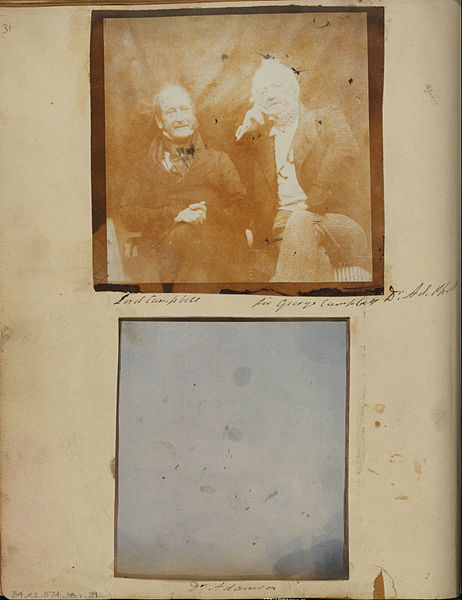
Photgraph taken by Scottish photographer Dr John Adamson (1810 – 1870) of Lord Campbell (great great great uncle) and his brother Sir George Campbell (great great grandfather) in 1842

Marriage and issue
Married to Margaret Christie (great great grandmother), daughter of A. Christie of Ferry bank. Sons George, John Scarlett and Charles.
Lord John Campbell, first Baron Campbell (15 Sep 1779 – 23 Jun 1861)
My 2nd great-grandfather George’s young brother, my third great uncle, was Lord John Campbell, first Baron Campbell John – legal biographer, lord chief justice, and lord chancellor.
St Andrews Records
Student United College
1790/91 Latin Junior; Greek Junior
1791/92 Latin Provectior; Greek Junior
1792/93 Latin Provectior; Greek Provectior; Logic
1793/94 Latin Provectior; Greek Provectior; Mathematics Junior; Natural Philosophy; Ethics; Civil History
1795/96 Natural Philosophy (Secondar). M.A. 1803 (Quaestor’s accounts only).
Student St Mary’s College 1794/95-1797/98. Foundation Bursar, 1794. Alexander bursar, 1796. LL.D. 14.11.1846.
Called to English bar in 1806 having entered Lincolns Inn 1800.
Treasurer of Lincoln Inn 1835 (The Treasurer is the head of the Inn and changes annually). The east window of Lincoln Inn Chapel shows the crests of the 228 Treasurers from 1680 to 1908, including his.
MP Stafford 1830 and subsequently for other places.
Held various high legal offices becoming Lord Chancellor in 1859.
Writings
- Life of John, Lord Campbell, Lord High Chancellor of Great Britain (2 vols, 1881 edited by his daughter, the Hon Mrs Hardcastle The family history is to be found within the first pages of Vol 1, written in his own words, as part of his unpublished memoirs, which he had begun in Oct 1842 after he had left the Bar to become Lord Chancellor of Ireland.
- The lives of the Lord Chancellors and Keepers of the Great Seal of England from the earliest times till the reign of King George IV. 7 [Paperback] John Campbell, Baron, 1779-1861 Campbell
- The lives of the Chief Justices of England from the Norman Conquest till the death of Lord Tenterden; Volume 2… by John Campbell, Baron, 1779-1861
- The lives of the chief justices of England. From the Norman conquest till the death of Lord Mansfield. by John Campbell, Baron, 1779-1861 Campbell (1 Jan 1849)
- Lives Of Lord Lyndhurst And Lord Brougham, Lord Chancellors And Keepers Of The Great Seal Of England by John Campbell, Baron, 1779-1861
- The lives of the chief justices of England by John Campbell, Baron, 1779-1861 Campbell (1 Jan 1849)
- Reports of Cases Determined at Nisi Prius: In the Courts of King’s Bench and Common Pleas, and . 4 [Paperback] John Campbell, Baron, 1779-1861 Campbell
- Shakespeare’s legal acquirements considered [Paperback] John Campbell Campbell Baron 1779-1861
John Scarlett Campbell (1825 – 1897)
Great grandfather
Born in Scotland. He embarked for India in September 1842, in company with his older brother George and younger brother Charles.
Writings
Campbell, J . Scarlett With reference to Sir James Stephen’s views on our Indian Frontier Policy London [s.n.], 1878.
Marriage and issue
First marriage to Henrietta Francis Bayley (1832 – Oct 1859) on 23 August 1856 at St. James Westminster. No issue. She did give birth to children while in India but they did not survive childhood.
Second marriage to Emma Benyon Ferguson (great grandmother) on 4 April 1861 in Warwickshire. Emma’s father was Thomas Ferguson. John and Emma had the following children:
- Henrietta Mary born 1862 in East Indies (great aunt)
- Charles Ferguson born 1864 in East Indies (Grandfather)
- Dorothy Scarlett born 1866 in East Indies (great aunt)
- Evelyn Constance born 1870 in London (great aunt)
m Dec 1891 either Ronald Montague Burrows or William Bellingham Jameson
Sir George Campbell (22 Mar 1824-1892)
John Scarlett’s older brother.
2nd great uncle
Indian administrator and author. At the age of eight, sent to the Edinburgh New Academy. After two years there he went for three years to Madras College, St. Andrews. He then spent two sessions at St. Andrews University.
St Andrews records
Student United College
1837/38 Latin Junior; Greek Junior; Mathematics 1
1838/39 Latin Provectior; Greek Provectior; Mathematics 2; Logic.
Went to India 1842 and served as a civil servant and magistrate. Lieutenant governor of Bengal 1871-1874 (retired).
KCSI 1873. MP for Kirkcaldy 1875-1892. Died at Cairo 18.2.1892.
Having obtained a nomination for the East India Company, he entered at Plaileybury, where, during two years, his chief subjects were history, political economy, and law.
He went to India in 1842 with his brothers John Scarlett and Charles. He married in 1853 Lsetitia, daughter of John Gowan Vibart, of the Bengal civil service, and left several children. He died at Cairo, from the effects of influenza, on 18 Feb. 1892, and was buried in the British Protestant cemetery there.
Writings
- ‘Memoirs of my Indian Career’, by Sir George Campbell, ed. Bernard with portrait; Gent. Mag. 1854, ii. 75, 76.
- ‘The Law applicable to the new Regulation Provinces of India, with Notes and Appendices,’ 1863, 8vo.
- ‘The Ethnology of India’ 1985
- The Capital of India, with some particulars of the Geography and Climate of that Country, pamphlet, 1865
- ‘Black and White : the Outcome of a Visit to the United States.’ 1879
- ‘A Handy Book on the Eastern Question,’ 1876, 8vo
- ‘The Afghan Frontier,’ a pamphlet, 1879, 8vo
- ‘The British Empire.’ 1887
- Ethnological subjects in the ‘Quarterly Ethnological Journal’ and the ‘Journal of the Bengal Asiatic Society’
- In 1874 he edited for the Bengal Secretarial Press ‘Specimens of the Language of India, including those of the Aboriginal Tribes of Bengal, the Central Provinces, and the Eastern Frontier.
Charles Ferguson Campbell (1864 – 1925)
Grandfather
Born in India. Lt-Col Chas Ferguson Campbell, CIE 1906, OBE 1920.
11th King Edwards Own Lancers, Probyn’s Horse 1906
Educated Haileybury & Sandhurst.
Served 1897-8 etc ADC to prince of Wales during Indian Tour 1905-6
Extra equerry to Prince of Wales 1906. Extra Equerry to King 1910.
Member of the Honorable Corps of gentlemen-at-Arms 1912
Address: Engine Court, St James Palace SW1.
Club: Navy and Military.
Marriage and issue
Married 1908 Mrs Emily Muirhead Gould (b 1867) of Bredisholm, Lanarkshire, daughter of R P Stewart (Robert Dalrymple Steuart Esq) Muirhead and widow of Col Arthur Gould (Queen’s Bays) with two children (son Gerald Gould and daughter Mignon Gould). Robert Dalrymple Steuart Esq. had married her mother Emily Eliza de Vernet Grosset-Muirhead in 1861, their daughter Emily (who married Charles Ferguson) was born in 1867 but in 1872 Robert was co-respondent in a court case in which Cecil Hughes accused him of committing adultery with his wife Baronne Isabelle Hubertine Emma Caroline Hughes nee Le Clement. They were seen together in a hotel in Brussels and Paris. They confessed to the Brussels affair but denied the Paris rendevouz. Cecil Hughes was granted damages of £5000. Robert Dalrymple Steuart Esq later married Baronne Isabelle Hughes.
Charles Campbell and Emily then lived at Salsey Lawn, Salsey Forest, Northamptonshire. He was 44 and she was 41 when they married. They had no issue. In 1951 Jack Gould of Hartwell wrote a ‘Local History of Hartwell’. This included a comment that “From 1834 the direct Parish responsibility for the ‘indigent poor’ almost ended, for outdoor relief was abolished, and the aged, infirm and orphaned were sent to the “Union” at Yardley Gobion.. A number of poor folk are recorded as having died there. The ‘White House’, as it was commonly called, which lingered to c1920, was a “grim institution”, and as a rule only those badly driven availed themselves of its tender mercies…. Within living memory charity took another form – that of bone soup. This was provided by Mrs Gould of Salcey Lawn and distributed at the house of Mr William Brice.”
Charles had a natural child, Reginald (Reg) Smith, to Winifred Smith (nee Brooks) in 1919 when he was 55 and she was 26. He initially paid for Reg to be fostered by a Mrs Watson (Emily Gould his wife paid the money). Apparently he stopped paying when Reg was about two years old. He died when Reg was aged six.
Reginald Smith (16 Mar 1919 -19 Feb 2004)
Father
Natural and only child of Chas Ferguson Campbell born to Winifred Lucy Smith, formerly Brooks (1893 – 19 ) of Winifred Lucy Brooks born, Newport Bagnell. She was 26. Born in Brackley Road Home (ie Towcester Union Workhouse) Towcester.
Reg was born three months after the end of WWI (Dec 1918). It is possible that Winfred Smith’s husband was still overseas at war when Reg was conceived (c Jun 1918).
Reg was fostered by Mrs W Watson. Payment sent by Mrs Muirhead Campbell, Salcey Lawn, Northampton 1 month in advance for R Smith. However by 1921 Reg was back living in the Towcester workhouse (aged about two years). On 2 Aug 1921 Winifred Smith agreed to Mrs E Goodyear adopting her child Reginald Smith (Towcester Union, Master’s Office, Workhouse, Towcester). Reg then aged 2 ½ years
Elizabeth Goodyear (b 1881) was the widow of William Goodyear killed in action WW1 between 1916 and 1919. They had one daughter, Constance Goodyear born 26 Oct 1900, Batley, West Yorks. She never married. Elizabeth and Constance Goodyear raised Reg. They lived in many villages around the district. In June 1933 they lived at Compton House, Grove Park, Buxton, Derbyshire and in Oct 1935 they lived at lived at the Croft, Hartwell. In 1933 Reg sang solo soprano as a choir boy in St Pauls Cathedral, Northampton. In 1934 Reg had meningitis (aged 15). He was well-known in the villages around Hartwell as the bastard son of Campbell.
He joined the Merchant navy aged 19 in 1938. WW II started May 1940. 15-16 Dec 1942 he was on the corvette Anemone which was caught in Atlantic storm after being sent to round up a convoy of 40-50 vessels which had disappeared in the storm. They arrived in port in England with list of 20 degrees from 200 tons of ice on deck. Later served in Egypt. He was pensioned out of the Navy with an injured back. Worked for optician Ian Prince then later immigrated to New Zealand in 1949 with Marie and daughter Jennifer. They travelled on the Rangitoto and met at least one of his aunts, Lady Campbell who recognised him. He wanted nothing to do with the Campbells.
Marriage and issue
Married Miriam Marie Yarrow, in Alexandria, Egypt on 24 March 1945 (both age 27). The War ended in May 1945 and in 1946 Marie returned to England.
Jennifer Elizabeth Smith born St Neats, Huntingshire 28 Apr 1946 and baptised, Paulersbury 29 Dec 1946.
Felicity Goodyear-Smith Born Auckland, New Zealand, 2 Sep 1952.
Reg, Marie and Felicity changed their name by deed poll to Goodyear-Smith
Sources
-
Research done by a distant relative named Jimmie Lee Robbins and documented on line
Wikipedia pages
